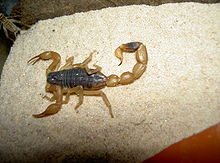- Mesobuthus martensii
-
Mesobuthus martensii 
Scientific classification Kingdom: Animalia Phylum: Arthropoda Class: Arachnida Order: Scorpiones Family: Buthidae Genus: Mesobuthus Species: M. martensii Binomial name Mesobuthus martensii
(Karsch, 1879)Synonyms [1][2][3] - Buthus martensi
- Buthus martensii Karsch
- Mesobuthus martensi
- Mesobuthus martensis
- Mesobuthus martensii martensii
- Buthus confucius
Mesobuthus martensii is a species of scorpion in the family Buthidae. Its common names include Chinese scorpion,[1][2] Manchurian scorpion,[1][2] Chinese armor-tail scorpion and Chinese golden scorpion. Despite its common name, this scorpion is not only found in Manchuria or China, but also in Mongolia, Korea and Japan.[3] Its preferred habitat is warm, dry areas with little vegetation. M. martensii can grow to about 6 centimetres (2.4 in) long, with females usually slightly larger, and has a life-span of about 4 to 6 years.
Taxonomic history
This species of scorpion was first described as Buthus martensii by German arachnologist Ferdinand Karsch in 1879.[1][3] Independently, Simon in 1880 described specimens he found in the gardens of the summer palace at Peking (present-day Beijing) as Buthus confucius, which Karsch synonymized as Buthus martensii in 1881.[3] Subsequently in 1950, it was transferred to Mesobuthus, a new genus established by French arachnologist Max Vachon.[1][3]
Uses
M. martensii, especially its tail, has been used in traditional Chinese medicine for many centuries to treat various neuronal problems, such as chronic pain, paralysis, apoplexy and epilepsy.[4][5][6] Over the past few decades, dozens of novel proteins in this scorpion's venom have been identified, cloned and investigated for clinical applications. For instance, at least 51 long-chain peptides related to the sodium channel toxins and 18 peptides related to the potassium channel toxins have been described, along with two peptides, AS1, that act on ryanodine receptors.[4] Apart from having analgesic properties,[6] BmK AS is also the first long-chain scorpion peptide reported to have antimicrobial activity.[7] Amongst the sodium channel-specific neurotoxins, there are a number of muscle relaxants, such as makatoxin I[8] and bukatoxin,[9] while BmKAEP[10][11] and anticonvulsant activity in experimental conditions, inhibiting epileptic seizures induced in rats. analgesic and antitumor properties and recombinant proteins could potentially be used in anticancer treatments.[13][14]
References
- ^ a b c d e Mesobuthus martensii at National Center for Biotechnology Information (NCBI) website.
- ^ a b c Mesobuthus martensii (Manchurian scorpion) (Buthus martensii), UniProt Taxonomy database
- ^ a b c d e Qi, Jian-Xin; Zhu, Ming-Sheng & Lourenço, Wilson R. (2004). "Redescription of Mesobuthus martensii martensii (Karsch, 1879) (Scorpiones: Buthidae) from China". Iberian Journal of Arachnology (Revista ibérica de aracnología) 10, 31-XII-2004: 137–144. ISSN 1576-9518. http://www.sea-entomologia.org/Publicaciones/RevistaIbericaAracnologia/RIA10/R10-012-137.pdf.
- ^ a b Goudet, C.; Chi, C. W.; Tytgat, J. (2002). "An overview of toxins and genes from the venom of the Asian scorpion Buthus martensi Karsch.". Toxicon (Elsevier) 40 (9): 1239–1258. doi:10.1016/S0041-0101(02)00142-3. ISSN 00410101. PMID 12220709.
- ^ Shao, Jianhua; Zhang, Rong; Ge, Xin: Yang, Bin; Zhang, Jinghai (2007). "Analgesic Peptides in Buthus martensii Karsch: A Traditional Chinese Animal Medicine". Asian Journal of Traditional Medicines 2 (2): 45–50. ISSN 1817-4337. http://www.asianjtm.com/qikan/manage/wenzhang/AJTM07-2%282%29-1.pdf.
- ^ a b Shao, Jianhua; Kang, Ning; Liu, Yanfeng; Song, Shuang; Wu, Chunfu; Zhang, Jinghai. (2007). "Purification and characterization of an analgesic peptide from Buthus martensii Karsch". Biomedical Chromatography (Wiley) 21 (12): 1266–1271. doi:10.1002/bmc.882. ISSN 02693879. PMID 17604360.
- ^ Shao, Jian-Hua; Yue-Qiu Wang, Xiao-Yan Wu, Rui Jiang, Rong Zhang, Chun-Fu Wu, Jing-Hai Zhang (2007). "Cloning, expression, and pharmacological activity of BmK AS, an active peptide from scorpion Buthus martensii Karsch". Biotechnology Letters 30 (1): 23–29. doi:10.1007/s10529-007-9499-y. ISSN 0141-5492. PMID 17701272. http://www.springerlink.com/content/w6295w7705u864u4/fulltext.pdf.
- ^ Gong, J.,; Kini R. M., Gwee M. C., Gopalakrishnakone P., Chung M. C. (1997). "Makatoxin I, a novel toxin isolated from the venom of she Scorpion Buthus martensi Karsch, exhibits nitrergic actions". Journal of Biological Chemistry 272 (13): 8320–8324. doi:10.1074/jbc.272.13.8320. ISSN 00219258. PMID 9079654.
- ^ Srinivasan, K. N.; S. Nirthanan, T. Sasaki, K. Sato, B. Cheng, M.C.E. Gwee, R. M. Kini, P. Gopalakrishnakone (2001). "Functional site of bukatoxin, an α-type sodium channel neurotoxin from the Chinese scorpion (Buthus martensi Karsch) venom: probable role of the 52PDKVP56 loop". FEBS Letters 494 (3): 145–149. doi:10.1016/S0014-5793(01)02342-0. ISSN 00145793. PMID 11311230.
- ^ Wang, Chun-Guang; He, Xiao-Lin; Shao, Feng; Liu, Wei; Ling, Min-Hua; Wang, Da-Cheng; Chi, Cheng-Wu (2001). "Molecular characterization of an anti-epilepsy peptide from the scorpion Buthus martensi Karsch". European Journal of Biochemistry 268 (8): 2480–5. doi:10.1046/j.1432-1327.2001.02132.x. PMID 11298767.
- ^ Zhou, X. H.; Yang, D.; Zhang, J. H.; Liu, C. M.; Lei, K. J. (1989). "Purification and N-terminal partial sequence of anti-epilepsy peptide from venom of the scorpion Buthus martensii Karsch". The Biochemical journal 257 (2): 509–17. PMC 1135608. PMID 2930463. http://www.pubmedcentral.nih.gov/articlerender.fcgi?tool=pmcentrez&artid=1135608.
- ^ Zhao, R.; X.-Y. Zhang, J. Yang, C.-C. Weng, L.-L. Jiang, J.-W. Zhang, X.-Q. Shu, Y.-H. Ji (2008). "Anticonvulsant effect of BmK IT2, a sodium channel-specific neurotoxin, in rat models of epilepsy". British Journal of Pharmacology 154 (5): 1116–1124. doi:10.1038/bjp.2008.156. ISSN 00071188. PMID 18587450.
- ^ Liu, Y; Ma R. L., Wang S. L., Duan Z. Y., Zhang J. H., Wu L. J., Wu C. F. (2003). "Expression of an antitumor–analgesic peptide from the venom of Chinese scorpion Buthus martensii karsch in Escherichia coli". Protein Expression and Purification 27 (2): 253–258. doi:10.1016/S1046-5928(02)00609-5. ISSN 10465928. PMID 12597884.
- ^ Liu, Yanfeng; Zhang, Zaiguo; Mao, Yingzi; Cui, Yong; Hu, Nan; Wang, Ying; Zhang, Jinghai. (2009). "Production and antitumor efficacy of recombinant Buthus martensii Karsch AGAP". Asian Journal of Traditional Medicines 4 (6): 228–233. ISSN 1817-4337. http://www.asianjtm.com/qikan/manage/wenzhang/AJTM2009,4%286%29-3.pdf.
Categories:- Scorpions
- Animals described in 1879
- Fauna of China
- Fauna of Korea
- Fauna of Japan
- Fauna of Mongolia
Wikimedia Foundation. 2010.
